The Theory of Financial Distress in Start-ups
VerifiedAdded on 2023/06/03
|16
|4802
|395
AI Summary
This essay explores the probability through formulation of a probabilistic model of the likelihood that the start-up would face the financial distress at a future course of time. It is considered that if start-up organizations could manage their financial capital required funds in their business then they could easily sustain their business in long run.
Contribute Materials
Your contribution can guide someone’s learning journey. Share your
documents today.
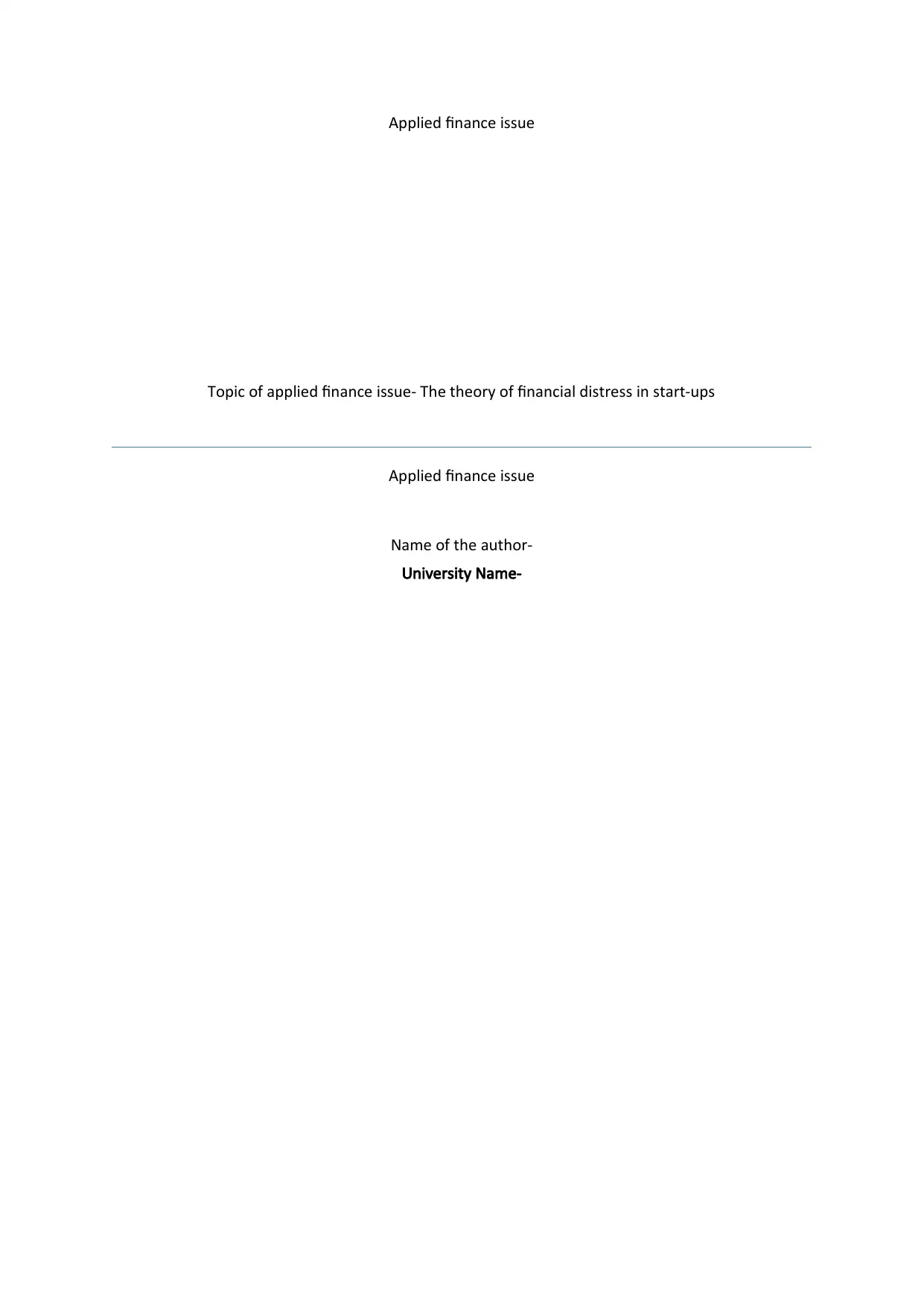
Applied finance issue
Topic of applied finance issue- The theory of financial distress in start-ups
Applied finance issue
Name of the author-
University Name-
Topic of applied finance issue- The theory of financial distress in start-ups
Applied finance issue
Name of the author-
University Name-
Secure Best Marks with AI Grader
Need help grading? Try our AI Grader for instant feedback on your assignments.
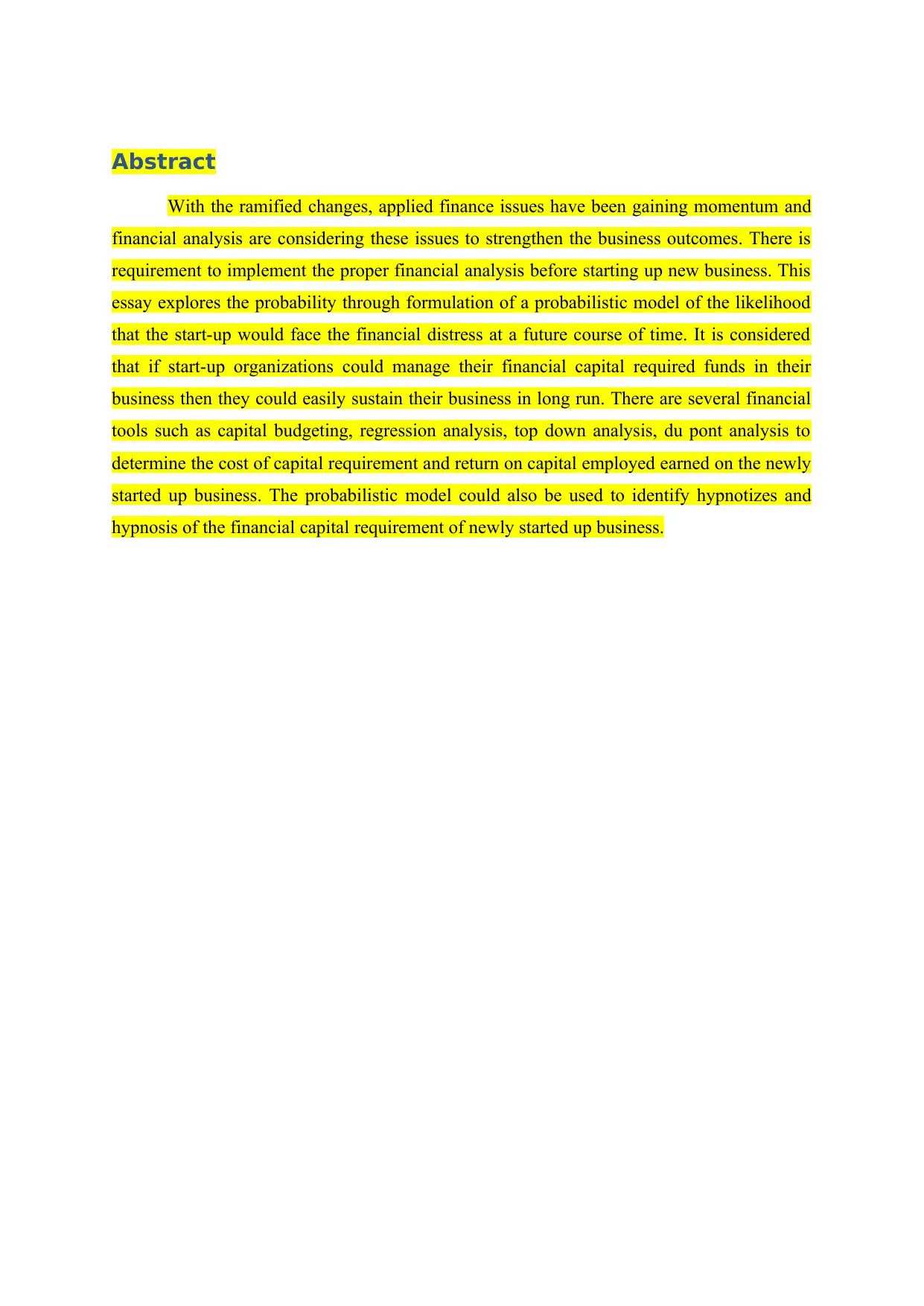
Abstract
With the ramified changes, applied finance issues have been gaining momentum and
financial analysis are considering these issues to strengthen the business outcomes. There is
requirement to implement the proper financial analysis before starting up new business. This
essay explores the probability through formulation of a probabilistic model of the likelihood
that the start-up would face the financial distress at a future course of time. It is considered
that if start-up organizations could manage their financial capital required funds in their
business then they could easily sustain their business in long run. There are several financial
tools such as capital budgeting, regression analysis, top down analysis, du pont analysis to
determine the cost of capital requirement and return on capital employed earned on the newly
started up business. The probabilistic model could also be used to identify hypnotizes and
hypnosis of the financial capital requirement of newly started up business.
With the ramified changes, applied finance issues have been gaining momentum and
financial analysis are considering these issues to strengthen the business outcomes. There is
requirement to implement the proper financial analysis before starting up new business. This
essay explores the probability through formulation of a probabilistic model of the likelihood
that the start-up would face the financial distress at a future course of time. It is considered
that if start-up organizations could manage their financial capital required funds in their
business then they could easily sustain their business in long run. There are several financial
tools such as capital budgeting, regression analysis, top down analysis, du pont analysis to
determine the cost of capital requirement and return on capital employed earned on the newly
started up business. The probabilistic model could also be used to identify hypnotizes and
hypnosis of the financial capital requirement of newly started up business.
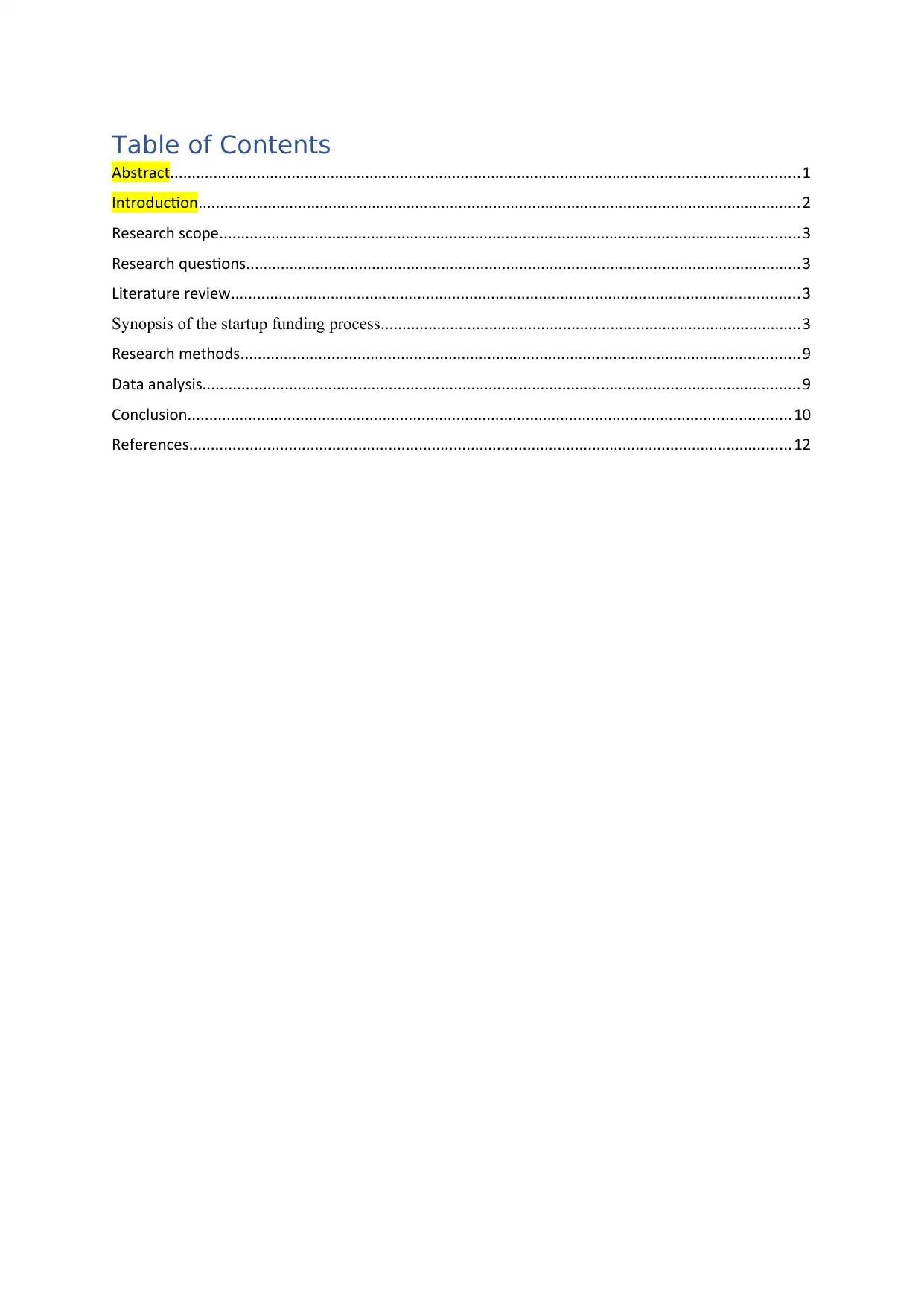
Table of Contents
Abstract.................................................................................................................................................1
Introduction...........................................................................................................................................2
Research scope......................................................................................................................................3
Research questions................................................................................................................................3
Literature review...................................................................................................................................3
Synopsis of the startup funding process.................................................................................................3
Research methods.................................................................................................................................9
Data analysis..........................................................................................................................................9
Conclusion...........................................................................................................................................10
References...........................................................................................................................................12
Abstract.................................................................................................................................................1
Introduction...........................................................................................................................................2
Research scope......................................................................................................................................3
Research questions................................................................................................................................3
Literature review...................................................................................................................................3
Synopsis of the startup funding process.................................................................................................3
Research methods.................................................................................................................................9
Data analysis..........................................................................................................................................9
Conclusion...........................................................................................................................................10
References...........................................................................................................................................12
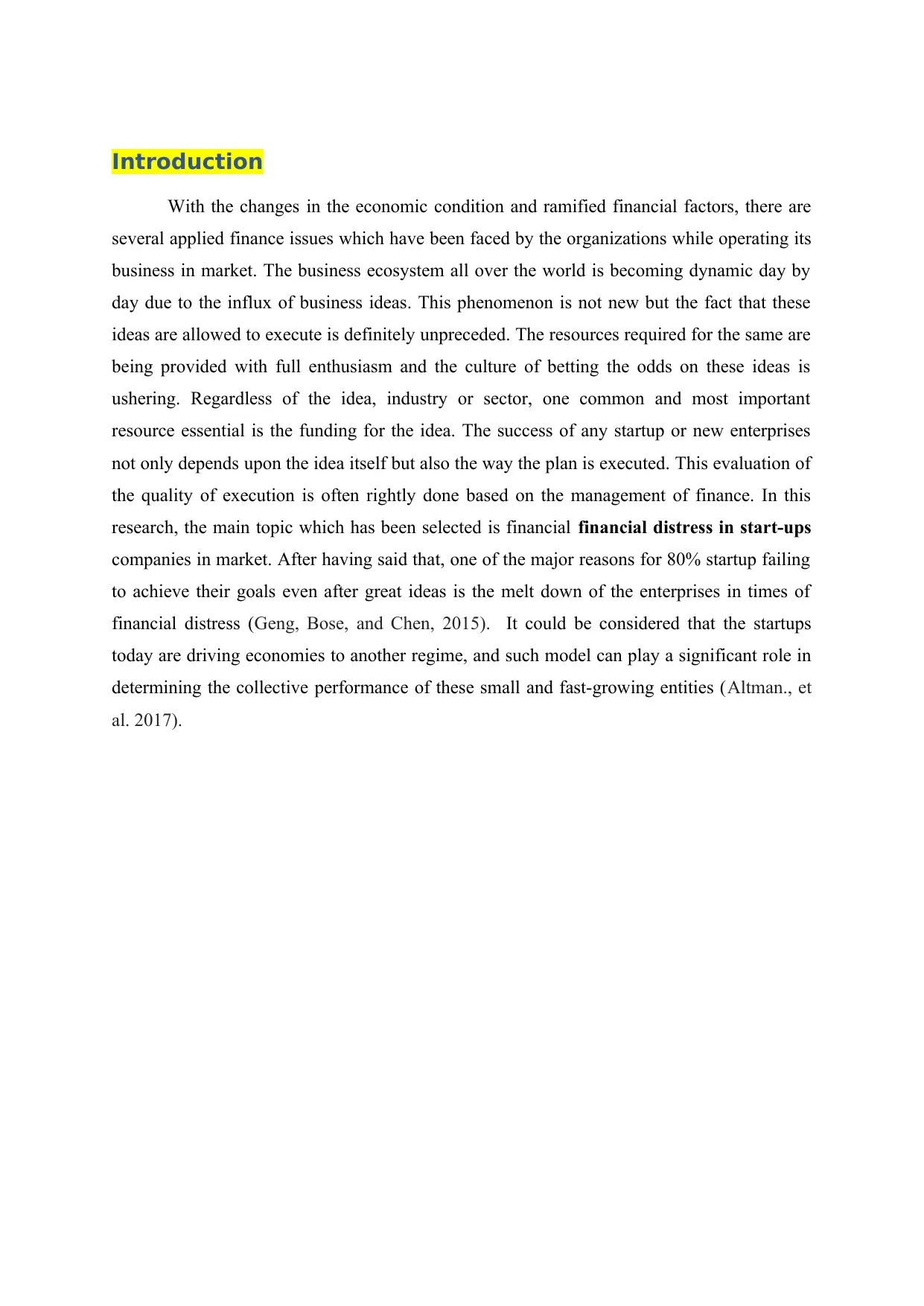
Introduction
With the changes in the economic condition and ramified financial factors, there are
several applied finance issues which have been faced by the organizations while operating its
business in market. The business ecosystem all over the world is becoming dynamic day by
day due to the influx of business ideas. This phenomenon is not new but the fact that these
ideas are allowed to execute is definitely unpreceded. The resources required for the same are
being provided with full enthusiasm and the culture of betting the odds on these ideas is
ushering. Regardless of the idea, industry or sector, one common and most important
resource essential is the funding for the idea. The success of any startup or new enterprises
not only depends upon the idea itself but also the way the plan is executed. This evaluation of
the quality of execution is often rightly done based on the management of finance. In this
research, the main topic which has been selected is financial financial distress in start-ups
companies in market. After having said that, one of the major reasons for 80% startup failing
to achieve their goals even after great ideas is the melt down of the enterprises in times of
financial distress (Geng, Bose, and Chen, 2015). It could be considered that the startups
today are driving economies to another regime, and such model can play a significant role in
determining the collective performance of these small and fast-growing entities (Altman., et
al. 2017).
With the changes in the economic condition and ramified financial factors, there are
several applied finance issues which have been faced by the organizations while operating its
business in market. The business ecosystem all over the world is becoming dynamic day by
day due to the influx of business ideas. This phenomenon is not new but the fact that these
ideas are allowed to execute is definitely unpreceded. The resources required for the same are
being provided with full enthusiasm and the culture of betting the odds on these ideas is
ushering. Regardless of the idea, industry or sector, one common and most important
resource essential is the funding for the idea. The success of any startup or new enterprises
not only depends upon the idea itself but also the way the plan is executed. This evaluation of
the quality of execution is often rightly done based on the management of finance. In this
research, the main topic which has been selected is financial financial distress in start-ups
companies in market. After having said that, one of the major reasons for 80% startup failing
to achieve their goals even after great ideas is the melt down of the enterprises in times of
financial distress (Geng, Bose, and Chen, 2015). It could be considered that the startups
today are driving economies to another regime, and such model can play a significant role in
determining the collective performance of these small and fast-growing entities (Altman., et
al. 2017).
Secure Best Marks with AI Grader
Need help grading? Try our AI Grader for instant feedback on your assignments.
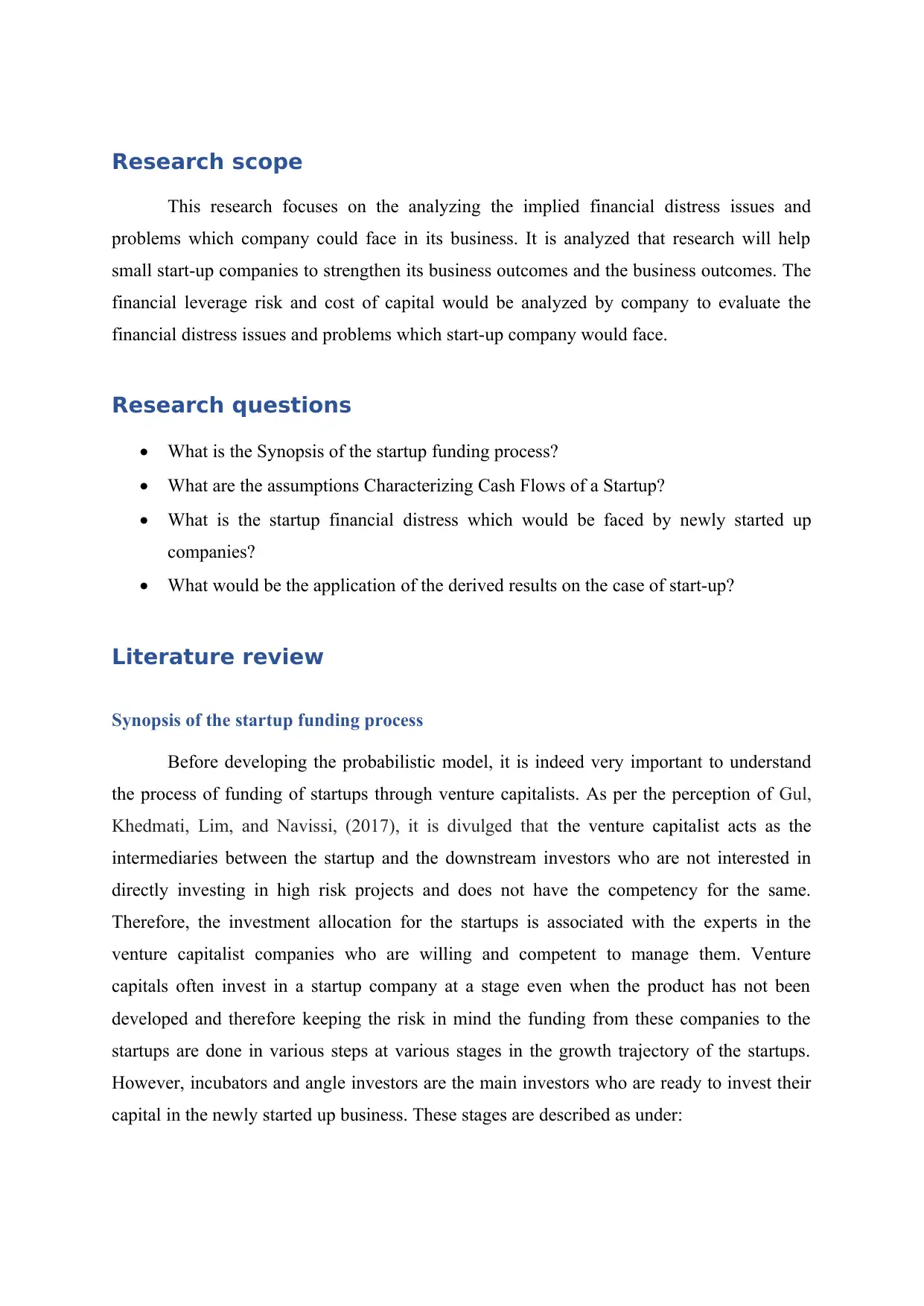
Research scope
This research focuses on the analyzing the implied financial distress issues and
problems which company could face in its business. It is analyzed that research will help
small start-up companies to strengthen its business outcomes and the business outcomes. The
financial leverage risk and cost of capital would be analyzed by company to evaluate the
financial distress issues and problems which start-up company would face.
Research questions
What is the Synopsis of the startup funding process?
What are the assumptions Characterizing Cash Flows of a Startup?
What is the startup financial distress which would be faced by newly started up
companies?
What would be the application of the derived results on the case of start-up?
Literature review
Synopsis of the startup funding process
Before developing the probabilistic model, it is indeed very important to understand
the process of funding of startups through venture capitalists. As per the perception of Gul,
Khedmati, Lim, and Navissi, (2017), it is divulged that the venture capitalist acts as the
intermediaries between the startup and the downstream investors who are not interested in
directly investing in high risk projects and does not have the competency for the same.
Therefore, the investment allocation for the startups is associated with the experts in the
venture capitalist companies who are willing and competent to manage them. Venture
capitals often invest in a startup company at a stage even when the product has not been
developed and therefore keeping the risk in mind the funding from these companies to the
startups are done in various steps at various stages in the growth trajectory of the startups.
However, incubators and angle investors are the main investors who are ready to invest their
capital in the newly started up business. These stages are described as under:
This research focuses on the analyzing the implied financial distress issues and
problems which company could face in its business. It is analyzed that research will help
small start-up companies to strengthen its business outcomes and the business outcomes. The
financial leverage risk and cost of capital would be analyzed by company to evaluate the
financial distress issues and problems which start-up company would face.
Research questions
What is the Synopsis of the startup funding process?
What are the assumptions Characterizing Cash Flows of a Startup?
What is the startup financial distress which would be faced by newly started up
companies?
What would be the application of the derived results on the case of start-up?
Literature review
Synopsis of the startup funding process
Before developing the probabilistic model, it is indeed very important to understand
the process of funding of startups through venture capitalists. As per the perception of Gul,
Khedmati, Lim, and Navissi, (2017), it is divulged that the venture capitalist acts as the
intermediaries between the startup and the downstream investors who are not interested in
directly investing in high risk projects and does not have the competency for the same.
Therefore, the investment allocation for the startups is associated with the experts in the
venture capitalist companies who are willing and competent to manage them. Venture
capitals often invest in a startup company at a stage even when the product has not been
developed and therefore keeping the risk in mind the funding from these companies to the
startups are done in various steps at various stages in the growth trajectory of the startups.
However, incubators and angle investors are the main investors who are ready to invest their
capital in the newly started up business. These stages are described as under:
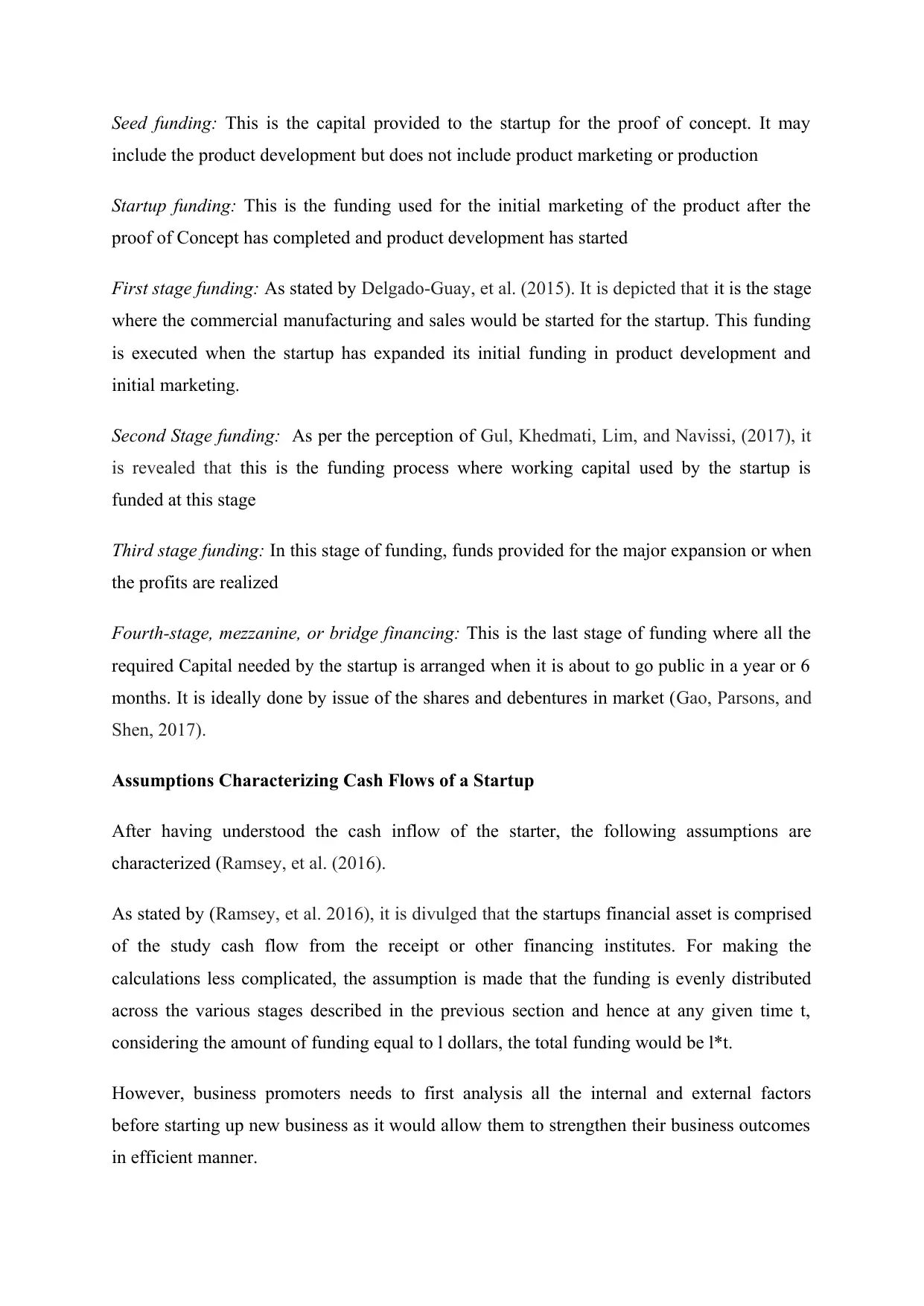
Seed funding: This is the capital provided to the startup for the proof of concept. It may
include the product development but does not include product marketing or production
Startup funding: This is the funding used for the initial marketing of the product after the
proof of Concept has completed and product development has started
First stage funding: As stated by Delgado-Guay, et al. (2015). It is depicted that it is the stage
where the commercial manufacturing and sales would be started for the startup. This funding
is executed when the startup has expanded its initial funding in product development and
initial marketing.
Second Stage funding: As per the perception of Gul, Khedmati, Lim, and Navissi, (2017), it
is revealed that this is the funding process where working capital used by the startup is
funded at this stage
Third stage funding: In this stage of funding, funds provided for the major expansion or when
the profits are realized
Fourth-stage, mezzanine, or bridge financing: This is the last stage of funding where all the
required Capital needed by the startup is arranged when it is about to go public in a year or 6
months. It is ideally done by issue of the shares and debentures in market (Gao, Parsons, and
Shen, 2017).
Assumptions Characterizing Cash Flows of a Startup
After having understood the cash inflow of the starter, the following assumptions are
characterized (Ramsey, et al. (2016).
As stated by (Ramsey, et al. 2016), it is divulged that the startups financial asset is comprised
of the study cash flow from the receipt or other financing institutes. For making the
calculations less complicated, the assumption is made that the funding is evenly distributed
across the various stages described in the previous section and hence at any given time t,
considering the amount of funding equal to l dollars, the total funding would be l*t.
However, business promoters needs to first analysis all the internal and external factors
before starting up new business as it would allow them to strengthen their business outcomes
in efficient manner.
include the product development but does not include product marketing or production
Startup funding: This is the funding used for the initial marketing of the product after the
proof of Concept has completed and product development has started
First stage funding: As stated by Delgado-Guay, et al. (2015). It is depicted that it is the stage
where the commercial manufacturing and sales would be started for the startup. This funding
is executed when the startup has expanded its initial funding in product development and
initial marketing.
Second Stage funding: As per the perception of Gul, Khedmati, Lim, and Navissi, (2017), it
is revealed that this is the funding process where working capital used by the startup is
funded at this stage
Third stage funding: In this stage of funding, funds provided for the major expansion or when
the profits are realized
Fourth-stage, mezzanine, or bridge financing: This is the last stage of funding where all the
required Capital needed by the startup is arranged when it is about to go public in a year or 6
months. It is ideally done by issue of the shares and debentures in market (Gao, Parsons, and
Shen, 2017).
Assumptions Characterizing Cash Flows of a Startup
After having understood the cash inflow of the starter, the following assumptions are
characterized (Ramsey, et al. (2016).
As stated by (Ramsey, et al. 2016), it is divulged that the startups financial asset is comprised
of the study cash flow from the receipt or other financing institutes. For making the
calculations less complicated, the assumption is made that the funding is evenly distributed
across the various stages described in the previous section and hence at any given time t,
considering the amount of funding equal to l dollars, the total funding would be l*t.
However, business promoters needs to first analysis all the internal and external factors
before starting up new business as it would allow them to strengthen their business outcomes
in efficient manner.
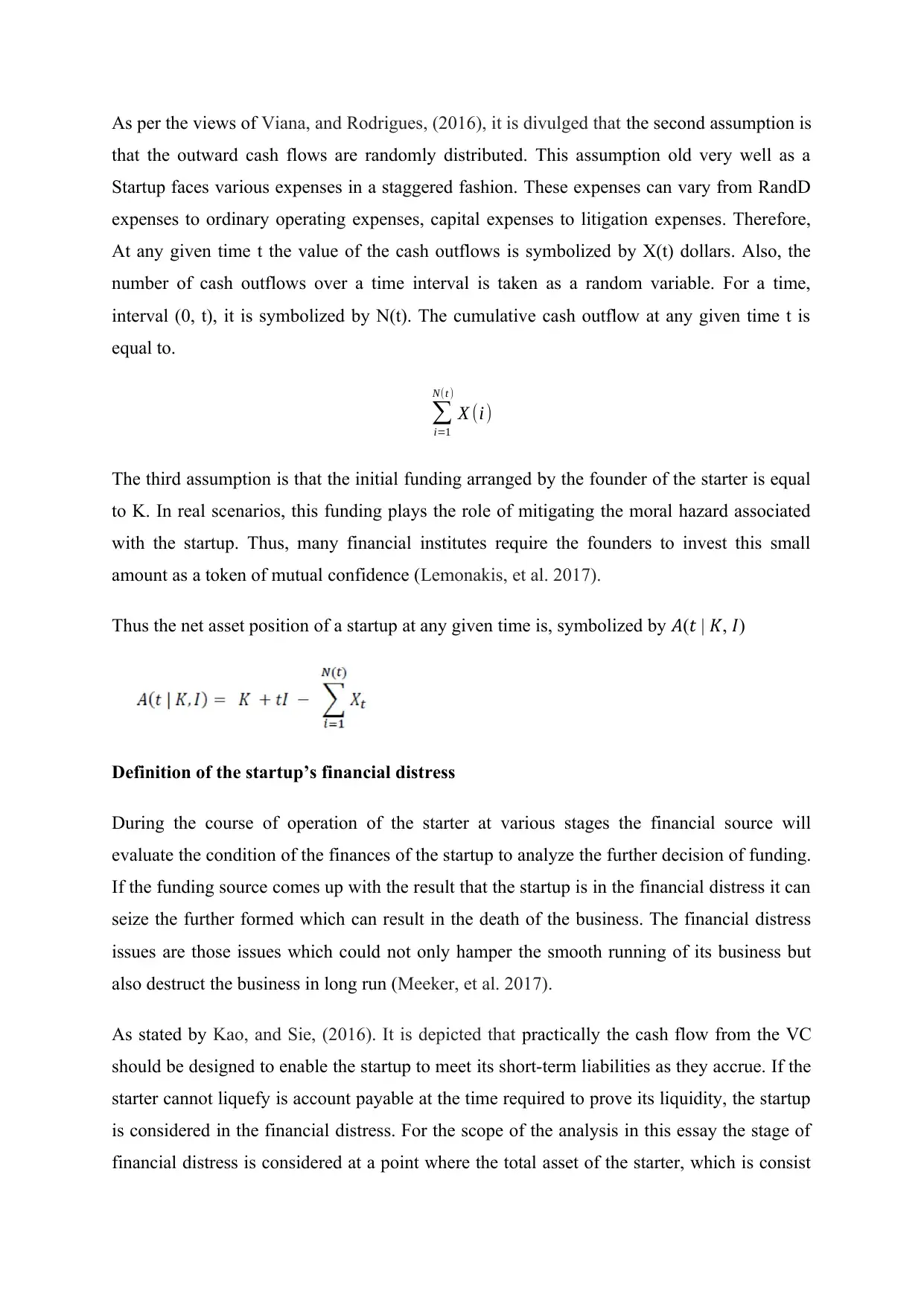
As per the views of Viana, and Rodrigues, (2016), it is divulged that the second assumption is
that the outward cash flows are randomly distributed. This assumption old very well as a
Startup faces various expenses in a staggered fashion. These expenses can vary from RandD
expenses to ordinary operating expenses, capital expenses to litigation expenses. Therefore,
At any given time t the value of the cash outflows is symbolized by X(t) dollars. Also, the
number of cash outflows over a time interval is taken as a random variable. For a time,
interval (0, t), it is symbolized by N(t). The cumulative cash outflow at any given time t is
equal to.
∑
i=1
N(t )
X (i)
The third assumption is that the initial funding arranged by the founder of the starter is equal
to K. In real scenarios, this funding plays the role of mitigating the moral hazard associated
with the startup. Thus, many financial institutes require the founders to invest this small
amount as a token of mutual confidence (Lemonakis, et al. 2017).
Thus the net asset position of a startup at any given time is, symbolized by 𝐴(𝑡 | 𝐾, 𝐼)
Definition of the startup’s financial distress
During the course of operation of the starter at various stages the financial source will
evaluate the condition of the finances of the startup to analyze the further decision of funding.
If the funding source comes up with the result that the startup is in the financial distress it can
seize the further formed which can result in the death of the business. The financial distress
issues are those issues which could not only hamper the smooth running of its business but
also destruct the business in long run (Meeker, et al. 2017).
As stated by Kao, and Sie, (2016). It is depicted that practically the cash flow from the VC
should be designed to enable the startup to meet its short-term liabilities as they accrue. If the
starter cannot liquefy is account payable at the time required to prove its liquidity, the startup
is considered in the financial distress. For the scope of the analysis in this essay the stage of
financial distress is considered at a point where the total asset of the starter, which is consist
that the outward cash flows are randomly distributed. This assumption old very well as a
Startup faces various expenses in a staggered fashion. These expenses can vary from RandD
expenses to ordinary operating expenses, capital expenses to litigation expenses. Therefore,
At any given time t the value of the cash outflows is symbolized by X(t) dollars. Also, the
number of cash outflows over a time interval is taken as a random variable. For a time,
interval (0, t), it is symbolized by N(t). The cumulative cash outflow at any given time t is
equal to.
∑
i=1
N(t )
X (i)
The third assumption is that the initial funding arranged by the founder of the starter is equal
to K. In real scenarios, this funding plays the role of mitigating the moral hazard associated
with the startup. Thus, many financial institutes require the founders to invest this small
amount as a token of mutual confidence (Lemonakis, et al. 2017).
Thus the net asset position of a startup at any given time is, symbolized by 𝐴(𝑡 | 𝐾, 𝐼)
Definition of the startup’s financial distress
During the course of operation of the starter at various stages the financial source will
evaluate the condition of the finances of the startup to analyze the further decision of funding.
If the funding source comes up with the result that the startup is in the financial distress it can
seize the further formed which can result in the death of the business. The financial distress
issues are those issues which could not only hamper the smooth running of its business but
also destruct the business in long run (Meeker, et al. 2017).
As stated by Kao, and Sie, (2016). It is depicted that practically the cash flow from the VC
should be designed to enable the startup to meet its short-term liabilities as they accrue. If the
starter cannot liquefy is account payable at the time required to prove its liquidity, the startup
is considered in the financial distress. For the scope of the analysis in this essay the stage of
financial distress is considered at a point where the total asset of the starter, which is consist
Paraphrase This Document
Need a fresh take? Get an instant paraphrase of this document with our AI Paraphraser
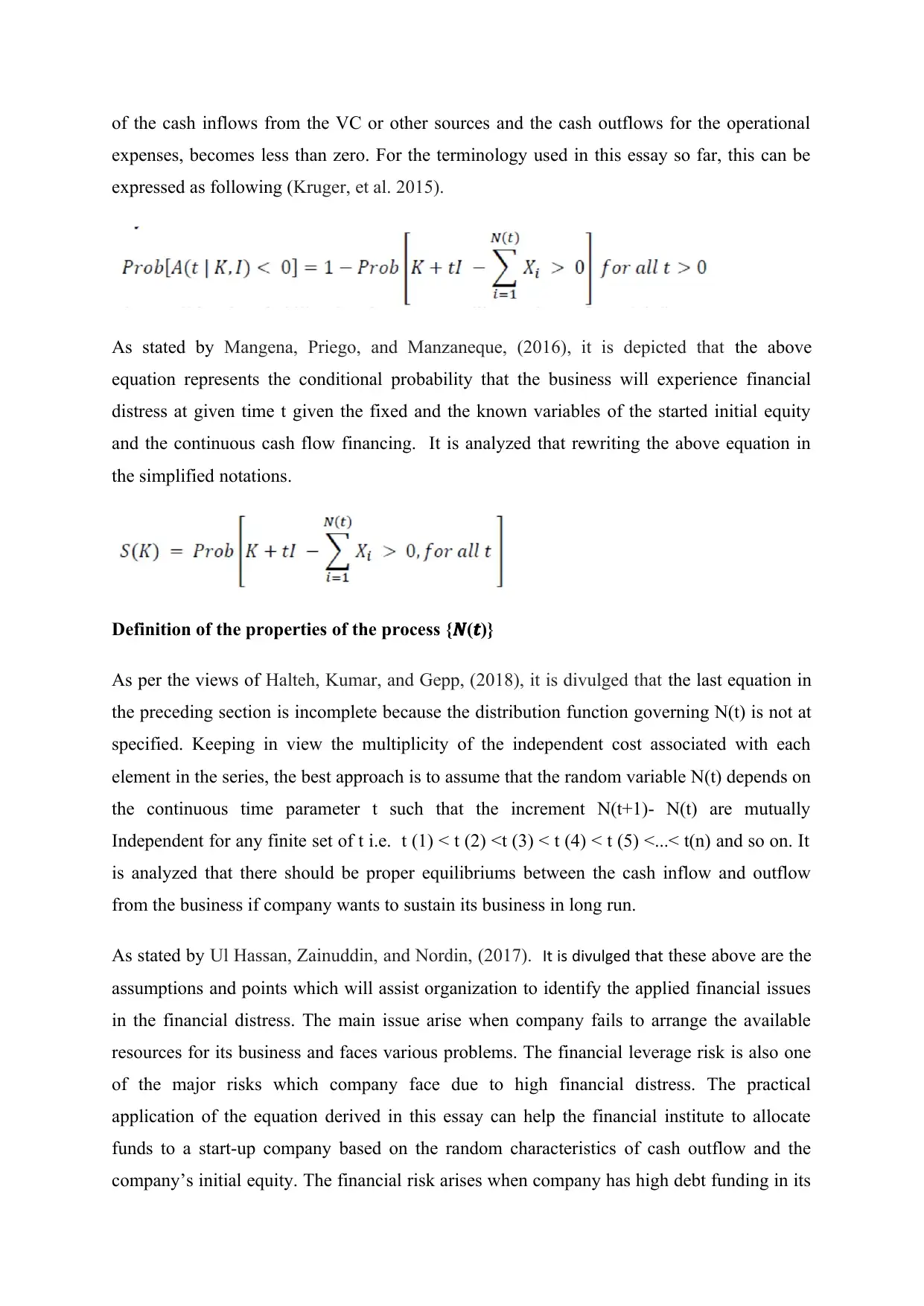
of the cash inflows from the VC or other sources and the cash outflows for the operational
expenses, becomes less than zero. For the terminology used in this essay so far, this can be
expressed as following (Kruger, et al. 2015).
As stated by Mangena, Priego, and Manzaneque, (2016), it is depicted that the above
equation represents the conditional probability that the business will experience financial
distress at given time t given the fixed and the known variables of the started initial equity
and the continuous cash flow financing. It is analyzed that rewriting the above equation in
the simplified notations.
Definition of the properties of the process {𝑵(𝒕)}
As per the views of Halteh, Kumar, and Gepp, (2018), it is divulged that the last equation in
the preceding section is incomplete because the distribution function governing N(t) is not at
specified. Keeping in view the multiplicity of the independent cost associated with each
element in the series, the best approach is to assume that the random variable N(t) depends on
the continuous time parameter t such that the increment N(t+1)- N(t) are mutually
Independent for any finite set of t i.e. t (1) < t (2) <t (3) < t (4) < t (5) <...< t(n) and so on. It
is analyzed that there should be proper equilibriums between the cash inflow and outflow
from the business if company wants to sustain its business in long run.
As stated by Ul Hassan, Zainuddin, and Nordin, (2017). It is divulged that these above are the
assumptions and points which will assist organization to identify the applied financial issues
in the financial distress. The main issue arise when company fails to arrange the available
resources for its business and faces various problems. The financial leverage risk is also one
of the major risks which company face due to high financial distress. The practical
application of the equation derived in this essay can help the financial institute to allocate
funds to a start-up company based on the random characteristics of cash outflow and the
company’s initial equity. The financial risk arises when company has high debt funding in its
expenses, becomes less than zero. For the terminology used in this essay so far, this can be
expressed as following (Kruger, et al. 2015).
As stated by Mangena, Priego, and Manzaneque, (2016), it is depicted that the above
equation represents the conditional probability that the business will experience financial
distress at given time t given the fixed and the known variables of the started initial equity
and the continuous cash flow financing. It is analyzed that rewriting the above equation in
the simplified notations.
Definition of the properties of the process {𝑵(𝒕)}
As per the views of Halteh, Kumar, and Gepp, (2018), it is divulged that the last equation in
the preceding section is incomplete because the distribution function governing N(t) is not at
specified. Keeping in view the multiplicity of the independent cost associated with each
element in the series, the best approach is to assume that the random variable N(t) depends on
the continuous time parameter t such that the increment N(t+1)- N(t) are mutually
Independent for any finite set of t i.e. t (1) < t (2) <t (3) < t (4) < t (5) <...< t(n) and so on. It
is analyzed that there should be proper equilibriums between the cash inflow and outflow
from the business if company wants to sustain its business in long run.
As stated by Ul Hassan, Zainuddin, and Nordin, (2017). It is divulged that these above are the
assumptions and points which will assist organization to identify the applied financial issues
in the financial distress. The main issue arise when company fails to arrange the available
resources for its business and faces various problems. The financial leverage risk is also one
of the major risks which company face due to high financial distress. The practical
application of the equation derived in this essay can help the financial institute to allocate
funds to a start-up company based on the random characteristics of cash outflow and the
company’s initial equity. The financial risk arises when company has high debt funding in its
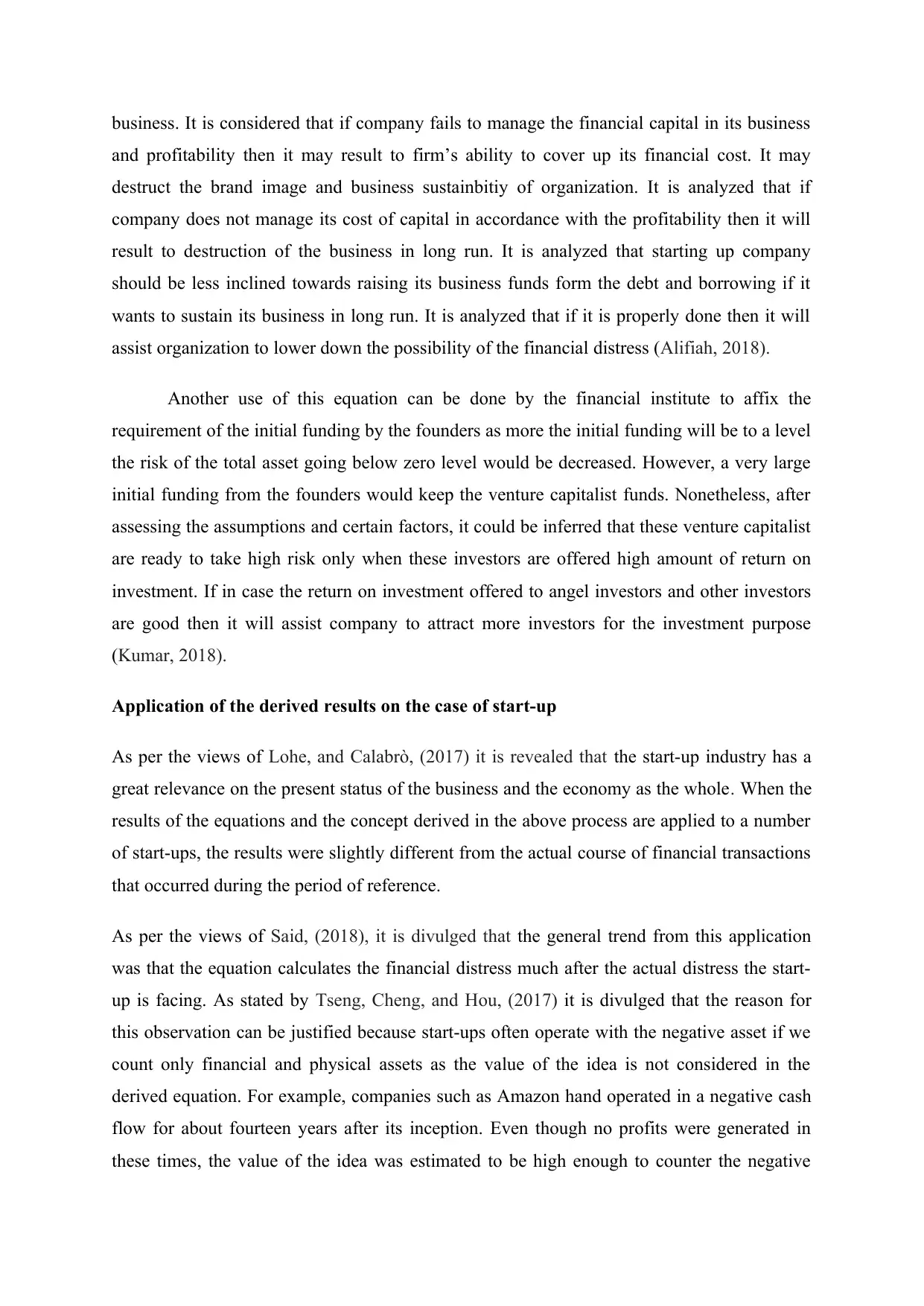
business. It is considered that if company fails to manage the financial capital in its business
and profitability then it may result to firm’s ability to cover up its financial cost. It may
destruct the brand image and business sustainbitiy of organization. It is analyzed that if
company does not manage its cost of capital in accordance with the profitability then it will
result to destruction of the business in long run. It is analyzed that starting up company
should be less inclined towards raising its business funds form the debt and borrowing if it
wants to sustain its business in long run. It is analyzed that if it is properly done then it will
assist organization to lower down the possibility of the financial distress (Alifiah, 2018).
Another use of this equation can be done by the financial institute to affix the
requirement of the initial funding by the founders as more the initial funding will be to a level
the risk of the total asset going below zero level would be decreased. However, a very large
initial funding from the founders would keep the venture capitalist funds. Nonetheless, after
assessing the assumptions and certain factors, it could be inferred that these venture capitalist
are ready to take high risk only when these investors are offered high amount of return on
investment. If in case the return on investment offered to angel investors and other investors
are good then it will assist company to attract more investors for the investment purpose
(Kumar, 2018).
Application of the derived results on the case of start-up
As per the views of Lohe, and Calabrò, (2017) it is revealed that the start-up industry has a
great relevance on the present status of the business and the economy as the whole. When the
results of the equations and the concept derived in the above process are applied to a number
of start-ups, the results were slightly different from the actual course of financial transactions
that occurred during the period of reference.
As per the views of Said, (2018), it is divulged that the general trend from this application
was that the equation calculates the financial distress much after the actual distress the start-
up is facing. As stated by Tseng, Cheng, and Hou, (2017) it is divulged that the reason for
this observation can be justified because start-ups often operate with the negative asset if we
count only financial and physical assets as the value of the idea is not considered in the
derived equation. For example, companies such as Amazon hand operated in a negative cash
flow for about fourteen years after its inception. Even though no profits were generated in
these times, the value of the idea was estimated to be high enough to counter the negative
and profitability then it may result to firm’s ability to cover up its financial cost. It may
destruct the brand image and business sustainbitiy of organization. It is analyzed that if
company does not manage its cost of capital in accordance with the profitability then it will
result to destruction of the business in long run. It is analyzed that starting up company
should be less inclined towards raising its business funds form the debt and borrowing if it
wants to sustain its business in long run. It is analyzed that if it is properly done then it will
assist organization to lower down the possibility of the financial distress (Alifiah, 2018).
Another use of this equation can be done by the financial institute to affix the
requirement of the initial funding by the founders as more the initial funding will be to a level
the risk of the total asset going below zero level would be decreased. However, a very large
initial funding from the founders would keep the venture capitalist funds. Nonetheless, after
assessing the assumptions and certain factors, it could be inferred that these venture capitalist
are ready to take high risk only when these investors are offered high amount of return on
investment. If in case the return on investment offered to angel investors and other investors
are good then it will assist company to attract more investors for the investment purpose
(Kumar, 2018).
Application of the derived results on the case of start-up
As per the views of Lohe, and Calabrò, (2017) it is revealed that the start-up industry has a
great relevance on the present status of the business and the economy as the whole. When the
results of the equations and the concept derived in the above process are applied to a number
of start-ups, the results were slightly different from the actual course of financial transactions
that occurred during the period of reference.
As per the views of Said, (2018), it is divulged that the general trend from this application
was that the equation calculates the financial distress much after the actual distress the start-
up is facing. As stated by Tseng, Cheng, and Hou, (2017) it is divulged that the reason for
this observation can be justified because start-ups often operate with the negative asset if we
count only financial and physical assets as the value of the idea is not considered in the
derived equation. For example, companies such as Amazon hand operated in a negative cash
flow for about fourteen years after its inception. Even though no profits were generated in
these times, the value of the idea was estimated to be high enough to counter the negative
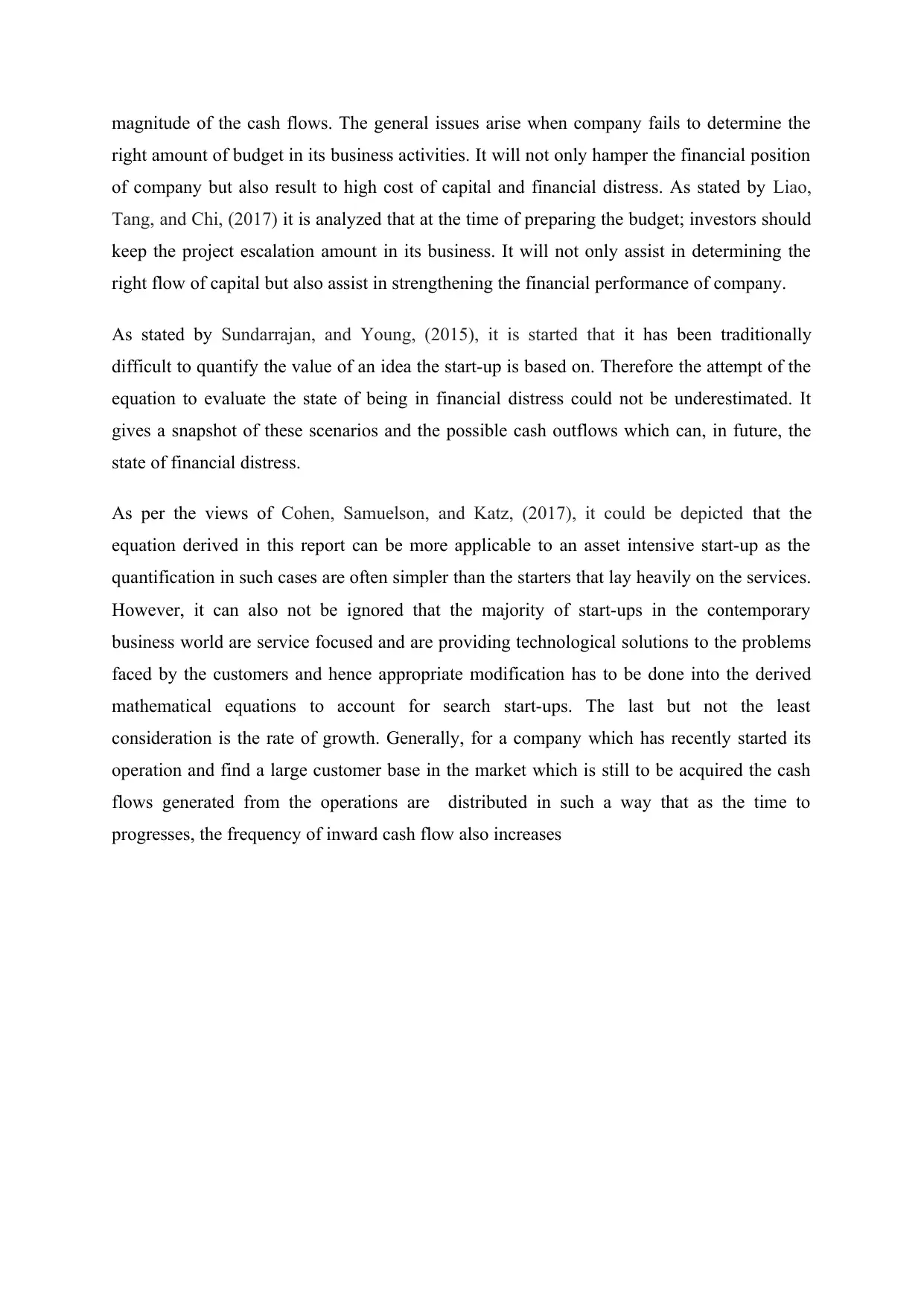
magnitude of the cash flows. The general issues arise when company fails to determine the
right amount of budget in its business activities. It will not only hamper the financial position
of company but also result to high cost of capital and financial distress. As stated by Liao,
Tang, and Chi, (2017) it is analyzed that at the time of preparing the budget; investors should
keep the project escalation amount in its business. It will not only assist in determining the
right flow of capital but also assist in strengthening the financial performance of company.
As stated by Sundarrajan, and Young, (2015), it is started that it has been traditionally
difficult to quantify the value of an idea the start-up is based on. Therefore the attempt of the
equation to evaluate the state of being in financial distress could not be underestimated. It
gives a snapshot of these scenarios and the possible cash outflows which can, in future, the
state of financial distress.
As per the views of Cohen, Samuelson, and Katz, (2017), it could be depicted that the
equation derived in this report can be more applicable to an asset intensive start-up as the
quantification in such cases are often simpler than the starters that lay heavily on the services.
However, it can also not be ignored that the majority of start-ups in the contemporary
business world are service focused and are providing technological solutions to the problems
faced by the customers and hence appropriate modification has to be done into the derived
mathematical equations to account for search start-ups. The last but not the least
consideration is the rate of growth. Generally, for a company which has recently started its
operation and find a large customer base in the market which is still to be acquired the cash
flows generated from the operations are distributed in such a way that as the time to
progresses, the frequency of inward cash flow also increases
right amount of budget in its business activities. It will not only hamper the financial position
of company but also result to high cost of capital and financial distress. As stated by Liao,
Tang, and Chi, (2017) it is analyzed that at the time of preparing the budget; investors should
keep the project escalation amount in its business. It will not only assist in determining the
right flow of capital but also assist in strengthening the financial performance of company.
As stated by Sundarrajan, and Young, (2015), it is started that it has been traditionally
difficult to quantify the value of an idea the start-up is based on. Therefore the attempt of the
equation to evaluate the state of being in financial distress could not be underestimated. It
gives a snapshot of these scenarios and the possible cash outflows which can, in future, the
state of financial distress.
As per the views of Cohen, Samuelson, and Katz, (2017), it could be depicted that the
equation derived in this report can be more applicable to an asset intensive start-up as the
quantification in such cases are often simpler than the starters that lay heavily on the services.
However, it can also not be ignored that the majority of start-ups in the contemporary
business world are service focused and are providing technological solutions to the problems
faced by the customers and hence appropriate modification has to be done into the derived
mathematical equations to account for search start-ups. The last but not the least
consideration is the rate of growth. Generally, for a company which has recently started its
operation and find a large customer base in the market which is still to be acquired the cash
flows generated from the operations are distributed in such a way that as the time to
progresses, the frequency of inward cash flow also increases
Secure Best Marks with AI Grader
Need help grading? Try our AI Grader for instant feedback on your assignments.
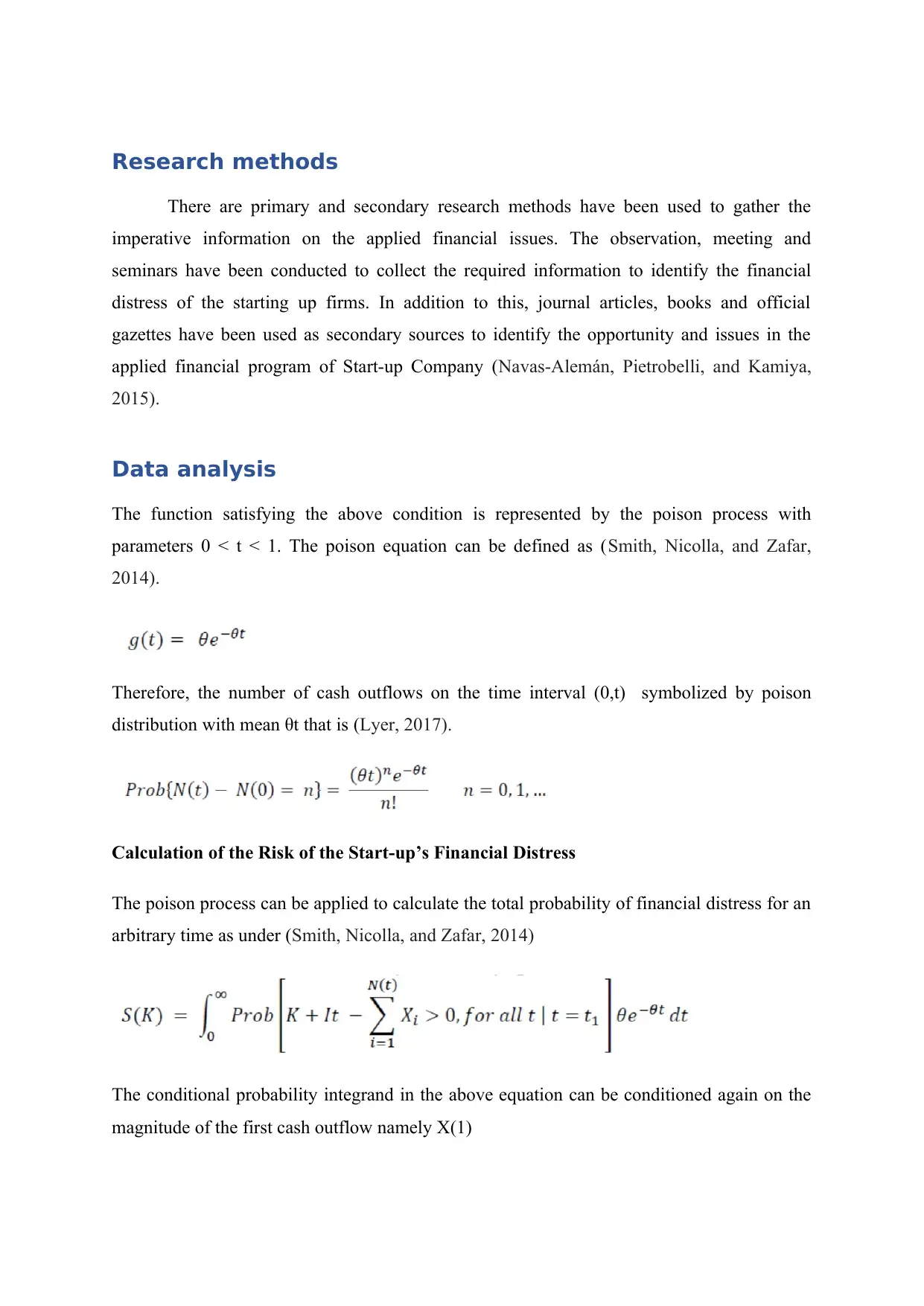
Research methods
There are primary and secondary research methods have been used to gather the
imperative information on the applied financial issues. The observation, meeting and
seminars have been conducted to collect the required information to identify the financial
distress of the starting up firms. In addition to this, journal articles, books and official
gazettes have been used as secondary sources to identify the opportunity and issues in the
applied financial program of Start-up Company (Navas-Alemán, Pietrobelli, and Kamiya,
2015).
Data analysis
The function satisfying the above condition is represented by the poison process with
parameters 0 < t < 1. The poison equation can be defined as (Smith, Nicolla, and Zafar,
2014).
Therefore, the number of cash outflows on the time interval (0,t) symbolized by poison
distribution with mean θt that is (Lyer, 2017).
Calculation of the Risk of the Start-up’s Financial Distress
The poison process can be applied to calculate the total probability of financial distress for an
arbitrary time as under (Smith, Nicolla, and Zafar, 2014)
The conditional probability integrand in the above equation can be conditioned again on the
magnitude of the first cash outflow namely X(1)
There are primary and secondary research methods have been used to gather the
imperative information on the applied financial issues. The observation, meeting and
seminars have been conducted to collect the required information to identify the financial
distress of the starting up firms. In addition to this, journal articles, books and official
gazettes have been used as secondary sources to identify the opportunity and issues in the
applied financial program of Start-up Company (Navas-Alemán, Pietrobelli, and Kamiya,
2015).
Data analysis
The function satisfying the above condition is represented by the poison process with
parameters 0 < t < 1. The poison equation can be defined as (Smith, Nicolla, and Zafar,
2014).
Therefore, the number of cash outflows on the time interval (0,t) symbolized by poison
distribution with mean θt that is (Lyer, 2017).
Calculation of the Risk of the Start-up’s Financial Distress
The poison process can be applied to calculate the total probability of financial distress for an
arbitrary time as under (Smith, Nicolla, and Zafar, 2014)
The conditional probability integrand in the above equation can be conditioned again on the
magnitude of the first cash outflow namely X(1)
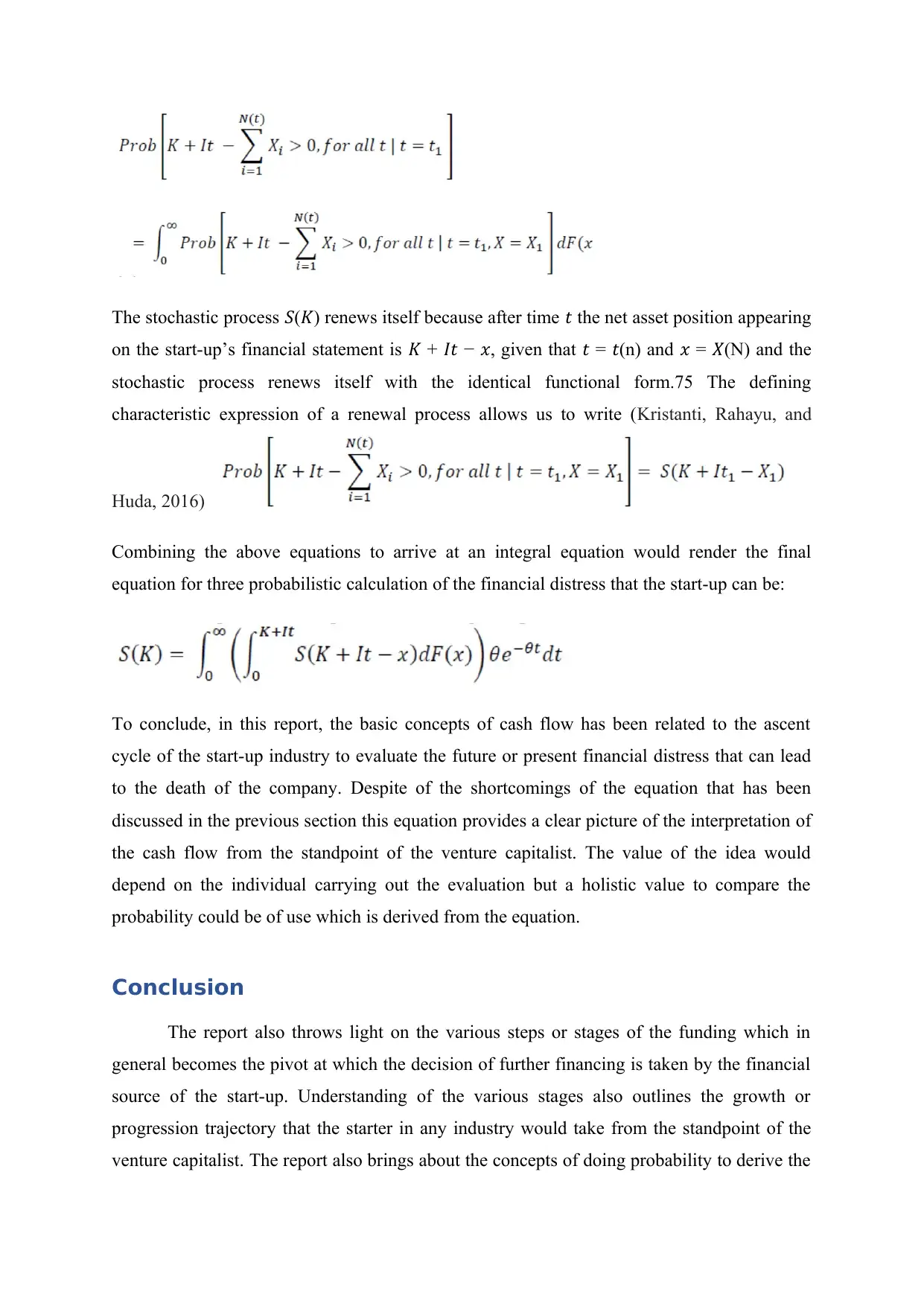
The stochastic process 𝑆(𝐾) renews itself because after time 𝑡 the net asset position appearing
on the start-up’s financial statement is 𝐾 + 𝐼𝑡 − 𝑥, given that 𝑡 = 𝑡(n) and 𝑥 = 𝑋(N) and the
stochastic process renews itself with the identical functional form.75 The defining
characteristic expression of a renewal process allows us to write (Kristanti, Rahayu, and
Huda, 2016)
Combining the above equations to arrive at an integral equation would render the final
equation for three probabilistic calculation of the financial distress that the start-up can be:
To conclude, in this report, the basic concepts of cash flow has been related to the ascent
cycle of the start-up industry to evaluate the future or present financial distress that can lead
to the death of the company. Despite of the shortcomings of the equation that has been
discussed in the previous section this equation provides a clear picture of the interpretation of
the cash flow from the standpoint of the venture capitalist. The value of the idea would
depend on the individual carrying out the evaluation but a holistic value to compare the
probability could be of use which is derived from the equation.
Conclusion
The report also throws light on the various steps or stages of the funding which in
general becomes the pivot at which the decision of further financing is taken by the financial
source of the start-up. Understanding of the various stages also outlines the growth or
progression trajectory that the starter in any industry would take from the standpoint of the
venture capitalist. The report also brings about the concepts of doing probability to derive the
on the start-up’s financial statement is 𝐾 + 𝐼𝑡 − 𝑥, given that 𝑡 = 𝑡(n) and 𝑥 = 𝑋(N) and the
stochastic process renews itself with the identical functional form.75 The defining
characteristic expression of a renewal process allows us to write (Kristanti, Rahayu, and
Huda, 2016)
Combining the above equations to arrive at an integral equation would render the final
equation for three probabilistic calculation of the financial distress that the start-up can be:
To conclude, in this report, the basic concepts of cash flow has been related to the ascent
cycle of the start-up industry to evaluate the future or present financial distress that can lead
to the death of the company. Despite of the shortcomings of the equation that has been
discussed in the previous section this equation provides a clear picture of the interpretation of
the cash flow from the standpoint of the venture capitalist. The value of the idea would
depend on the individual carrying out the evaluation but a holistic value to compare the
probability could be of use which is derived from the equation.
Conclusion
The report also throws light on the various steps or stages of the funding which in
general becomes the pivot at which the decision of further financing is taken by the financial
source of the start-up. Understanding of the various stages also outlines the growth or
progression trajectory that the starter in any industry would take from the standpoint of the
venture capitalist. The report also brings about the concepts of doing probability to derive the
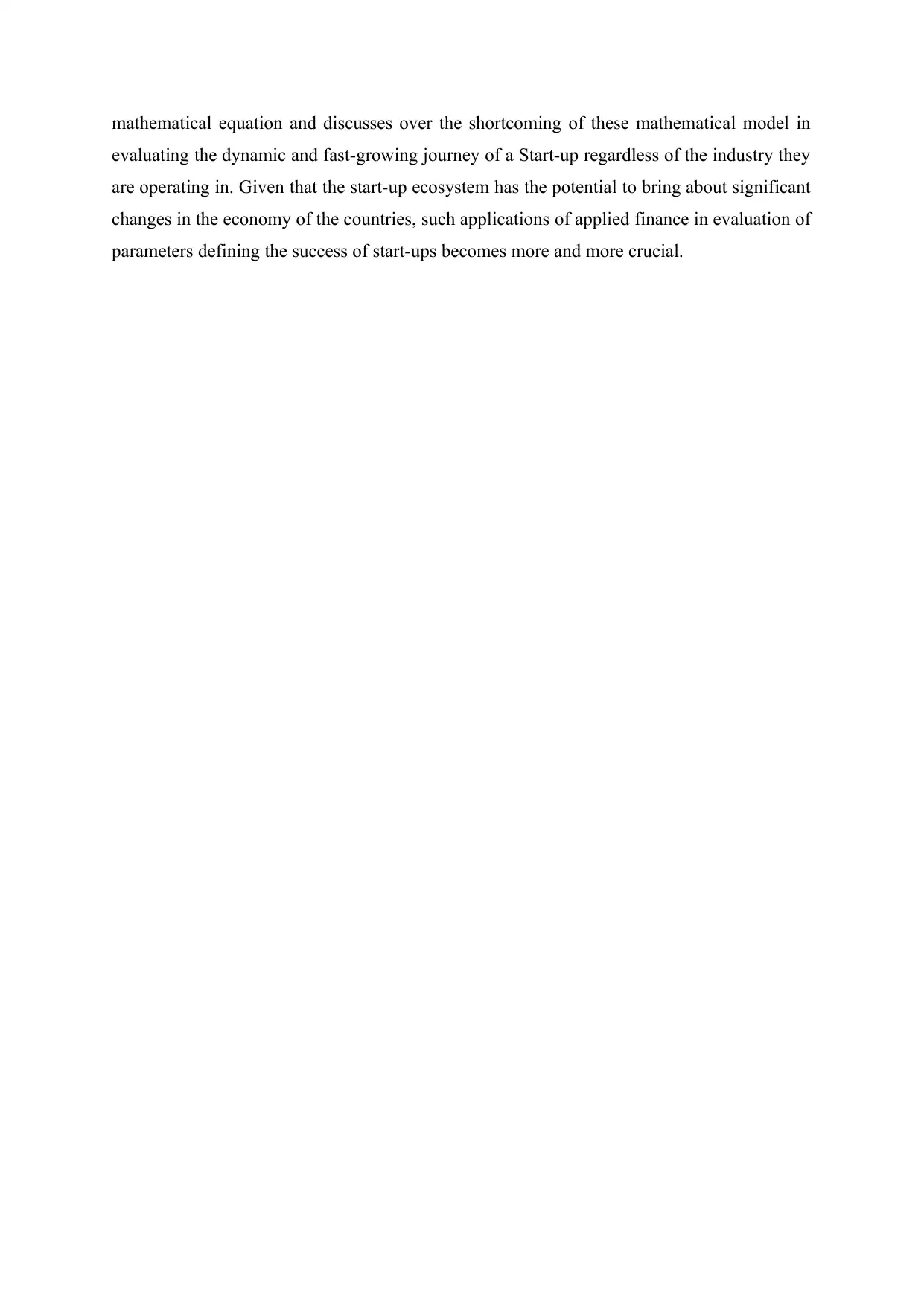
mathematical equation and discusses over the shortcoming of these mathematical model in
evaluating the dynamic and fast-growing journey of a Start-up regardless of the industry they
are operating in. Given that the start-up ecosystem has the potential to bring about significant
changes in the economy of the countries, such applications of applied finance in evaluation of
parameters defining the success of start-ups becomes more and more crucial.
evaluating the dynamic and fast-growing journey of a Start-up regardless of the industry they
are operating in. Given that the start-up ecosystem has the potential to bring about significant
changes in the economy of the countries, such applications of applied finance in evaluation of
parameters defining the success of start-ups becomes more and more crucial.
Paraphrase This Document
Need a fresh take? Get an instant paraphrase of this document with our AI Paraphraser
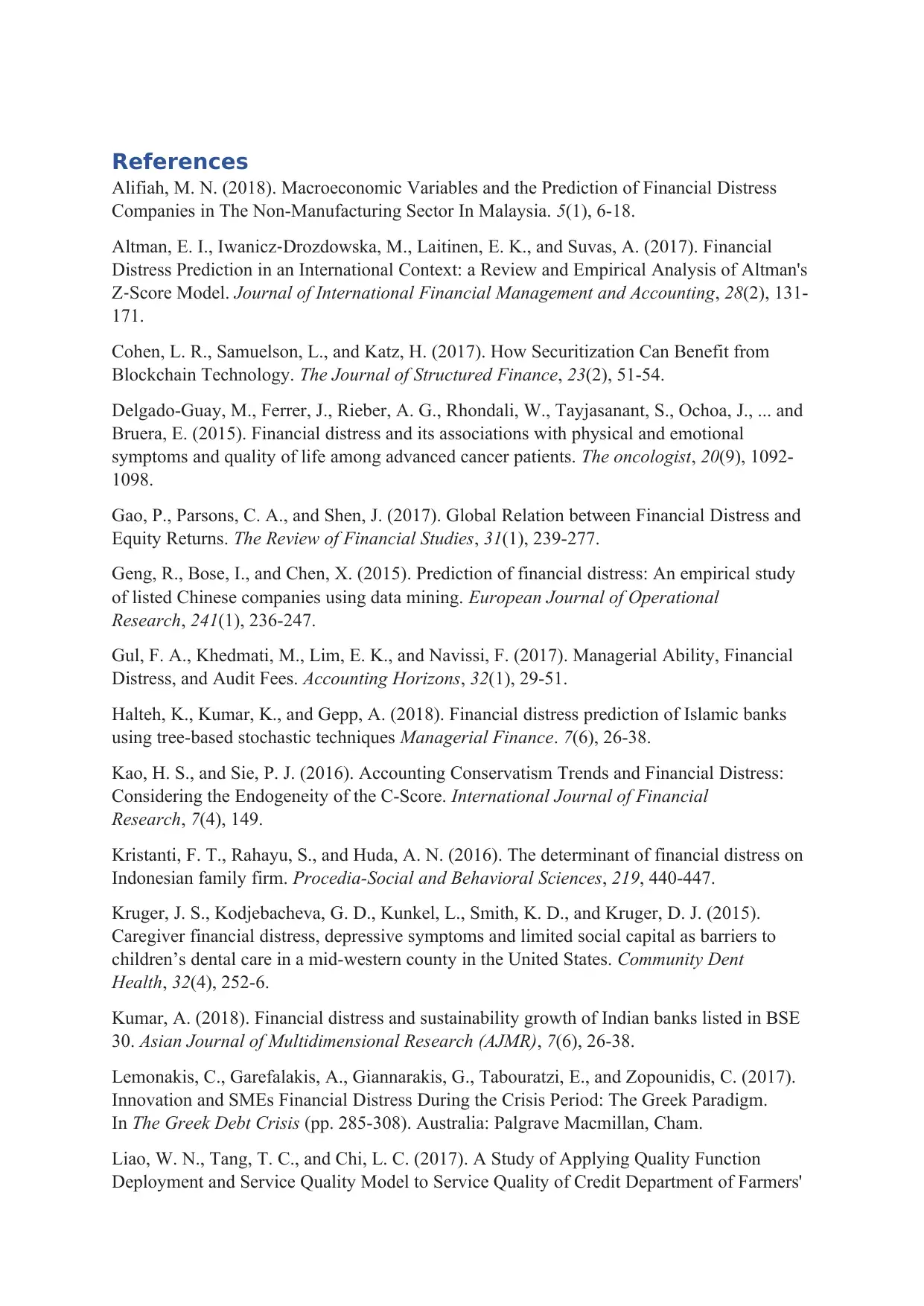
References
Alifiah, M. N. (2018). Macroeconomic Variables and the Prediction of Financial Distress
Companies in The Non-Manufacturing Sector In Malaysia. 5(1), 6-18.
Altman, E. I., Iwanicz‐Drozdowska, M., Laitinen, E. K., and Suvas, A. (2017). Financial
Distress Prediction in an International Context: a Review and Empirical Analysis of Altman's
Z‐Score Model. Journal of International Financial Management and Accounting, 28(2), 131-
171.
Cohen, L. R., Samuelson, L., and Katz, H. (2017). How Securitization Can Benefit from
Blockchain Technology. The Journal of Structured Finance, 23(2), 51-54.
Delgado-Guay, M., Ferrer, J., Rieber, A. G., Rhondali, W., Tayjasanant, S., Ochoa, J., ... and
Bruera, E. (2015). Financial distress and its associations with physical and emotional
symptoms and quality of life among advanced cancer patients. The oncologist, 20(9), 1092-
1098.
Gao, P., Parsons, C. A., and Shen, J. (2017). Global Relation between Financial Distress and
Equity Returns. The Review of Financial Studies, 31(1), 239-277.
Geng, R., Bose, I., and Chen, X. (2015). Prediction of financial distress: An empirical study
of listed Chinese companies using data mining. European Journal of Operational
Research, 241(1), 236-247.
Gul, F. A., Khedmati, M., Lim, E. K., and Navissi, F. (2017). Managerial Ability, Financial
Distress, and Audit Fees. Accounting Horizons, 32(1), 29-51.
Halteh, K., Kumar, K., and Gepp, A. (2018). Financial distress prediction of Islamic banks
using tree-based stochastic techniques Managerial Finance. 7(6), 26-38.
Kao, H. S., and Sie, P. J. (2016). Accounting Conservatism Trends and Financial Distress:
Considering the Endogeneity of the C-Score. International Journal of Financial
Research, 7(4), 149.
Kristanti, F. T., Rahayu, S., and Huda, A. N. (2016). The determinant of financial distress on
Indonesian family firm. Procedia-Social and Behavioral Sciences, 219, 440-447.
Kruger, J. S., Kodjebacheva, G. D., Kunkel, L., Smith, K. D., and Kruger, D. J. (2015).
Caregiver financial distress, depressive symptoms and limited social capital as barriers to
children’s dental care in a mid-western county in the United States. Community Dent
Health, 32(4), 252-6.
Kumar, A. (2018). Financial distress and sustainability growth of Indian banks listed in BSE
30. Asian Journal of Multidimensional Research (AJMR), 7(6), 26-38.
Lemonakis, C., Garefalakis, A., Giannarakis, G., Tabouratzi, E., and Zopounidis, C. (2017).
Innovation and SMEs Financial Distress During the Crisis Period: The Greek Paradigm.
In The Greek Debt Crisis (pp. 285-308). Australia: Palgrave Macmillan, Cham.
Liao, W. N., Tang, T. C., and Chi, L. C. (2017). A Study of Applying Quality Function
Deployment and Service Quality Model to Service Quality of Credit Department of Farmers'
Alifiah, M. N. (2018). Macroeconomic Variables and the Prediction of Financial Distress
Companies in The Non-Manufacturing Sector In Malaysia. 5(1), 6-18.
Altman, E. I., Iwanicz‐Drozdowska, M., Laitinen, E. K., and Suvas, A. (2017). Financial
Distress Prediction in an International Context: a Review and Empirical Analysis of Altman's
Z‐Score Model. Journal of International Financial Management and Accounting, 28(2), 131-
171.
Cohen, L. R., Samuelson, L., and Katz, H. (2017). How Securitization Can Benefit from
Blockchain Technology. The Journal of Structured Finance, 23(2), 51-54.
Delgado-Guay, M., Ferrer, J., Rieber, A. G., Rhondali, W., Tayjasanant, S., Ochoa, J., ... and
Bruera, E. (2015). Financial distress and its associations with physical and emotional
symptoms and quality of life among advanced cancer patients. The oncologist, 20(9), 1092-
1098.
Gao, P., Parsons, C. A., and Shen, J. (2017). Global Relation between Financial Distress and
Equity Returns. The Review of Financial Studies, 31(1), 239-277.
Geng, R., Bose, I., and Chen, X. (2015). Prediction of financial distress: An empirical study
of listed Chinese companies using data mining. European Journal of Operational
Research, 241(1), 236-247.
Gul, F. A., Khedmati, M., Lim, E. K., and Navissi, F. (2017). Managerial Ability, Financial
Distress, and Audit Fees. Accounting Horizons, 32(1), 29-51.
Halteh, K., Kumar, K., and Gepp, A. (2018). Financial distress prediction of Islamic banks
using tree-based stochastic techniques Managerial Finance. 7(6), 26-38.
Kao, H. S., and Sie, P. J. (2016). Accounting Conservatism Trends and Financial Distress:
Considering the Endogeneity of the C-Score. International Journal of Financial
Research, 7(4), 149.
Kristanti, F. T., Rahayu, S., and Huda, A. N. (2016). The determinant of financial distress on
Indonesian family firm. Procedia-Social and Behavioral Sciences, 219, 440-447.
Kruger, J. S., Kodjebacheva, G. D., Kunkel, L., Smith, K. D., and Kruger, D. J. (2015).
Caregiver financial distress, depressive symptoms and limited social capital as barriers to
children’s dental care in a mid-western county in the United States. Community Dent
Health, 32(4), 252-6.
Kumar, A. (2018). Financial distress and sustainability growth of Indian banks listed in BSE
30. Asian Journal of Multidimensional Research (AJMR), 7(6), 26-38.
Lemonakis, C., Garefalakis, A., Giannarakis, G., Tabouratzi, E., and Zopounidis, C. (2017).
Innovation and SMEs Financial Distress During the Crisis Period: The Greek Paradigm.
In The Greek Debt Crisis (pp. 285-308). Australia: Palgrave Macmillan, Cham.
Liao, W. N., Tang, T. C., and Chi, L. C. (2017). A Study of Applying Quality Function
Deployment and Service Quality Model to Service Quality of Credit Department of Farmers'
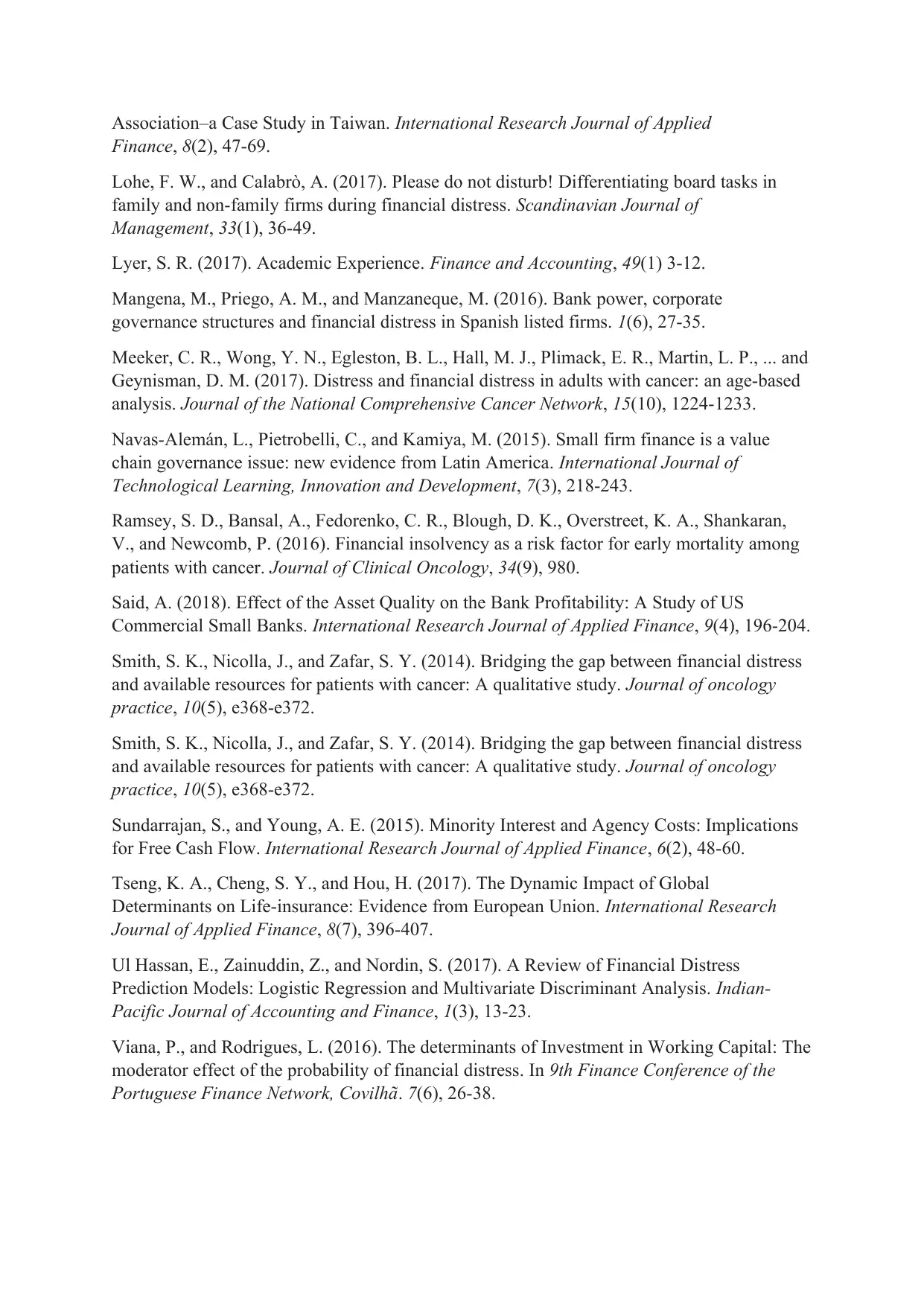
Association–a Case Study in Taiwan. International Research Journal of Applied
Finance, 8(2), 47-69.
Lohe, F. W., and Calabrò, A. (2017). Please do not disturb! Differentiating board tasks in
family and non-family firms during financial distress. Scandinavian Journal of
Management, 33(1), 36-49.
Lyer, S. R. (2017). Academic Experience. Finance and Accounting, 49(1) 3-12.
Mangena, M., Priego, A. M., and Manzaneque, M. (2016). Bank power, corporate
governance structures and financial distress in Spanish listed firms. 1(6), 27-35.
Meeker, C. R., Wong, Y. N., Egleston, B. L., Hall, M. J., Plimack, E. R., Martin, L. P., ... and
Geynisman, D. M. (2017). Distress and financial distress in adults with cancer: an age-based
analysis. Journal of the National Comprehensive Cancer Network, 15(10), 1224-1233.
Navas-Alemán, L., Pietrobelli, C., and Kamiya, M. (2015). Small firm finance is a value
chain governance issue: new evidence from Latin America. International Journal of
Technological Learning, Innovation and Development, 7(3), 218-243.
Ramsey, S. D., Bansal, A., Fedorenko, C. R., Blough, D. K., Overstreet, K. A., Shankaran,
V., and Newcomb, P. (2016). Financial insolvency as a risk factor for early mortality among
patients with cancer. Journal of Clinical Oncology, 34(9), 980.
Said, A. (2018). Effect of the Asset Quality on the Bank Profitability: A Study of US
Commercial Small Banks. International Research Journal of Applied Finance, 9(4), 196-204.
Smith, S. K., Nicolla, J., and Zafar, S. Y. (2014). Bridging the gap between financial distress
and available resources for patients with cancer: A qualitative study. Journal of oncology
practice, 10(5), e368-e372.
Smith, S. K., Nicolla, J., and Zafar, S. Y. (2014). Bridging the gap between financial distress
and available resources for patients with cancer: A qualitative study. Journal of oncology
practice, 10(5), e368-e372.
Sundarrajan, S., and Young, A. E. (2015). Minority Interest and Agency Costs: Implications
for Free Cash Flow. International Research Journal of Applied Finance, 6(2), 48-60.
Tseng, K. A., Cheng, S. Y., and Hou, H. (2017). The Dynamic Impact of Global
Determinants on Life-insurance: Evidence from European Union. International Research
Journal of Applied Finance, 8(7), 396-407.
Ul Hassan, E., Zainuddin, Z., and Nordin, S. (2017). A Review of Financial Distress
Prediction Models: Logistic Regression and Multivariate Discriminant Analysis. Indian-
Pacific Journal of Accounting and Finance, 1(3), 13-23.
Viana, P., and Rodrigues, L. (2016). The determinants of Investment in Working Capital: The
moderator effect of the probability of financial distress. In 9th Finance Conference of the
Portuguese Finance Network, Covilhã. 7(6), 26-38.
Finance, 8(2), 47-69.
Lohe, F. W., and Calabrò, A. (2017). Please do not disturb! Differentiating board tasks in
family and non-family firms during financial distress. Scandinavian Journal of
Management, 33(1), 36-49.
Lyer, S. R. (2017). Academic Experience. Finance and Accounting, 49(1) 3-12.
Mangena, M., Priego, A. M., and Manzaneque, M. (2016). Bank power, corporate
governance structures and financial distress in Spanish listed firms. 1(6), 27-35.
Meeker, C. R., Wong, Y. N., Egleston, B. L., Hall, M. J., Plimack, E. R., Martin, L. P., ... and
Geynisman, D. M. (2017). Distress and financial distress in adults with cancer: an age-based
analysis. Journal of the National Comprehensive Cancer Network, 15(10), 1224-1233.
Navas-Alemán, L., Pietrobelli, C., and Kamiya, M. (2015). Small firm finance is a value
chain governance issue: new evidence from Latin America. International Journal of
Technological Learning, Innovation and Development, 7(3), 218-243.
Ramsey, S. D., Bansal, A., Fedorenko, C. R., Blough, D. K., Overstreet, K. A., Shankaran,
V., and Newcomb, P. (2016). Financial insolvency as a risk factor for early mortality among
patients with cancer. Journal of Clinical Oncology, 34(9), 980.
Said, A. (2018). Effect of the Asset Quality on the Bank Profitability: A Study of US
Commercial Small Banks. International Research Journal of Applied Finance, 9(4), 196-204.
Smith, S. K., Nicolla, J., and Zafar, S. Y. (2014). Bridging the gap between financial distress
and available resources for patients with cancer: A qualitative study. Journal of oncology
practice, 10(5), e368-e372.
Smith, S. K., Nicolla, J., and Zafar, S. Y. (2014). Bridging the gap between financial distress
and available resources for patients with cancer: A qualitative study. Journal of oncology
practice, 10(5), e368-e372.
Sundarrajan, S., and Young, A. E. (2015). Minority Interest and Agency Costs: Implications
for Free Cash Flow. International Research Journal of Applied Finance, 6(2), 48-60.
Tseng, K. A., Cheng, S. Y., and Hou, H. (2017). The Dynamic Impact of Global
Determinants on Life-insurance: Evidence from European Union. International Research
Journal of Applied Finance, 8(7), 396-407.
Ul Hassan, E., Zainuddin, Z., and Nordin, S. (2017). A Review of Financial Distress
Prediction Models: Logistic Regression and Multivariate Discriminant Analysis. Indian-
Pacific Journal of Accounting and Finance, 1(3), 13-23.
Viana, P., and Rodrigues, L. (2016). The determinants of Investment in Working Capital: The
moderator effect of the probability of financial distress. In 9th Finance Conference of the
Portuguese Finance Network, Covilhã. 7(6), 26-38.

1 out of 16
Related Documents
Your All-in-One AI-Powered Toolkit for Academic Success.
+13062052269
info@desklib.com
Available 24*7 on WhatsApp / Email
![[object Object]](/_next/static/media/star-bottom.7253800d.svg)
Unlock your academic potential
© 2024 | Zucol Services PVT LTD | All rights reserved.




